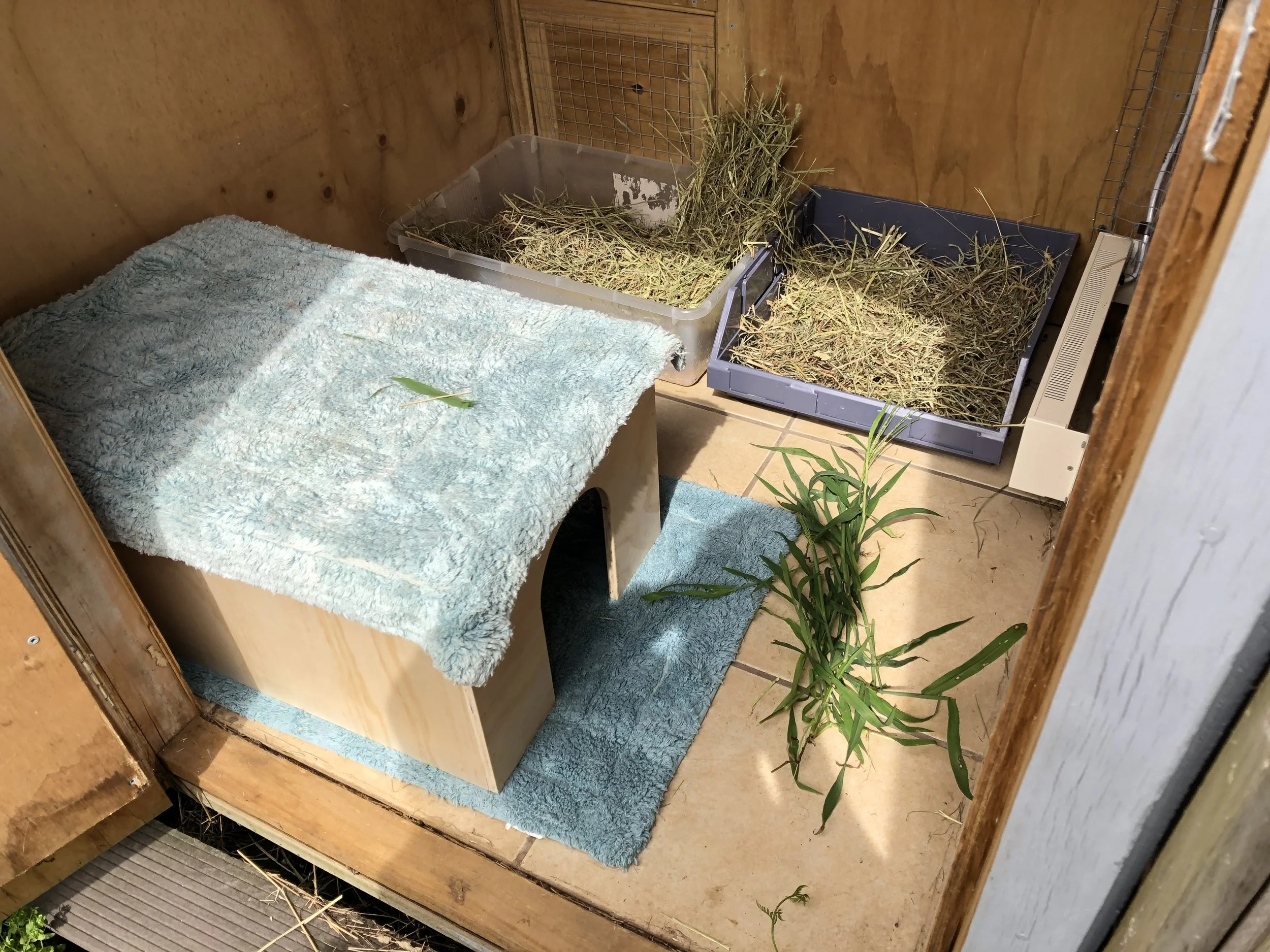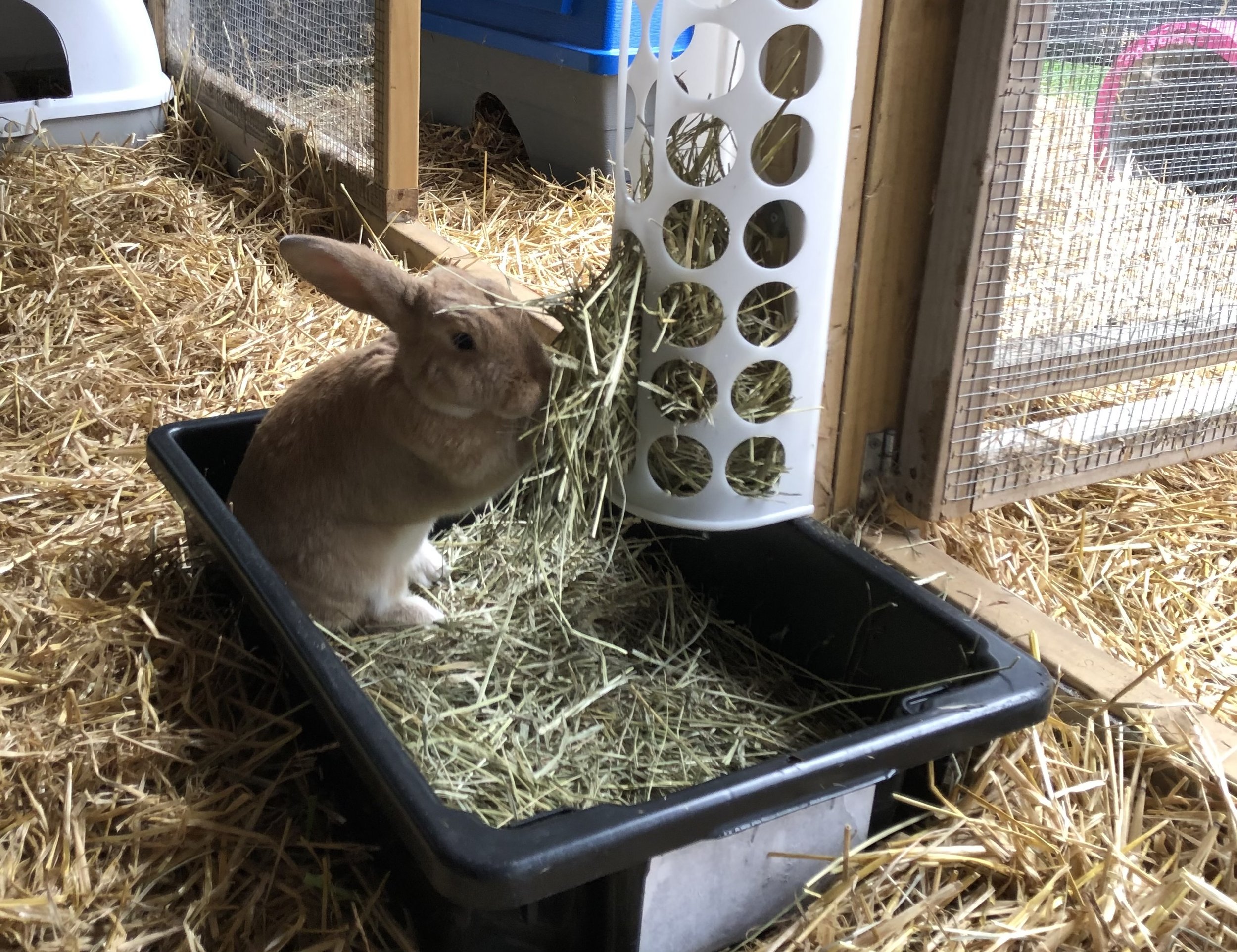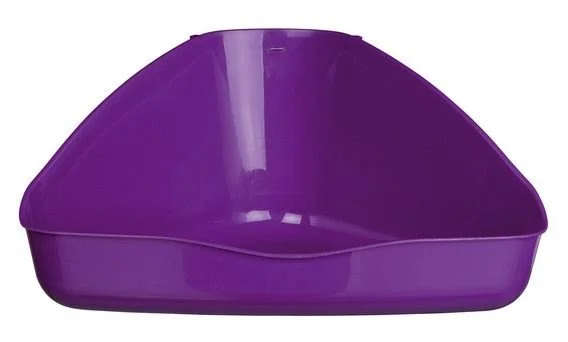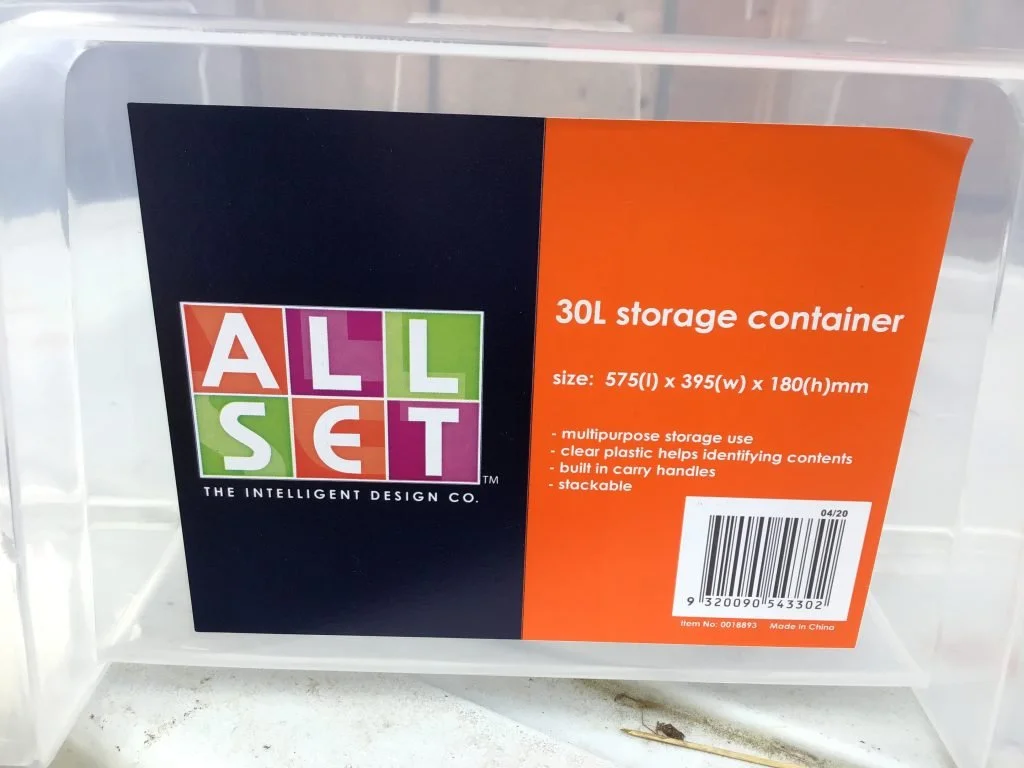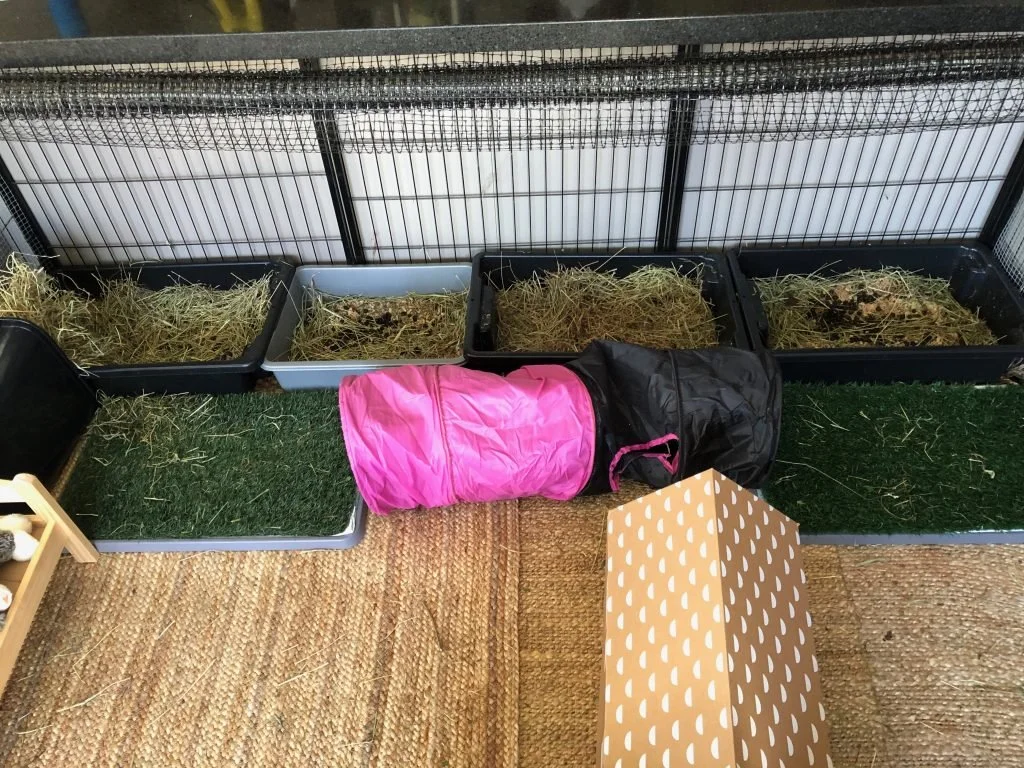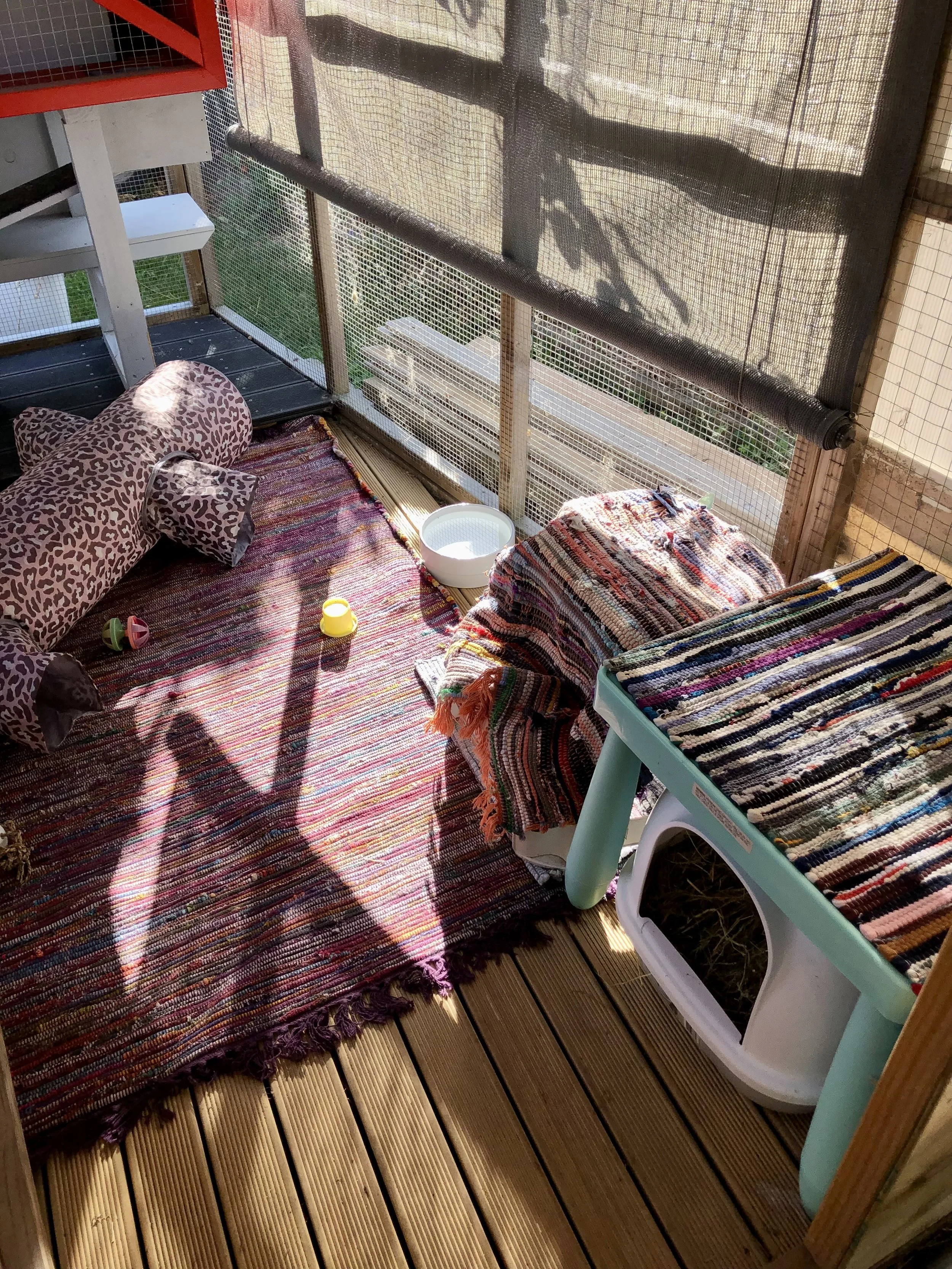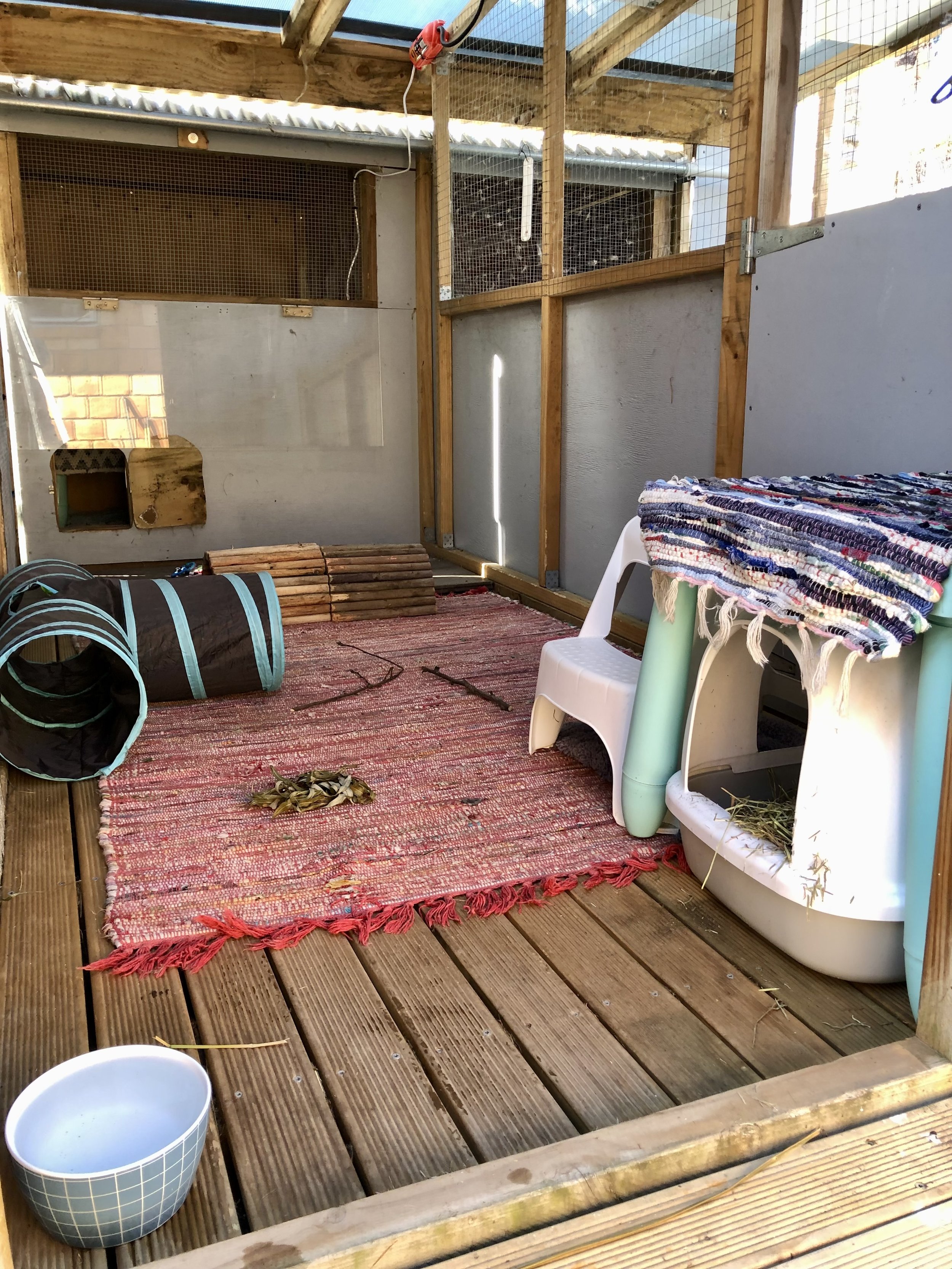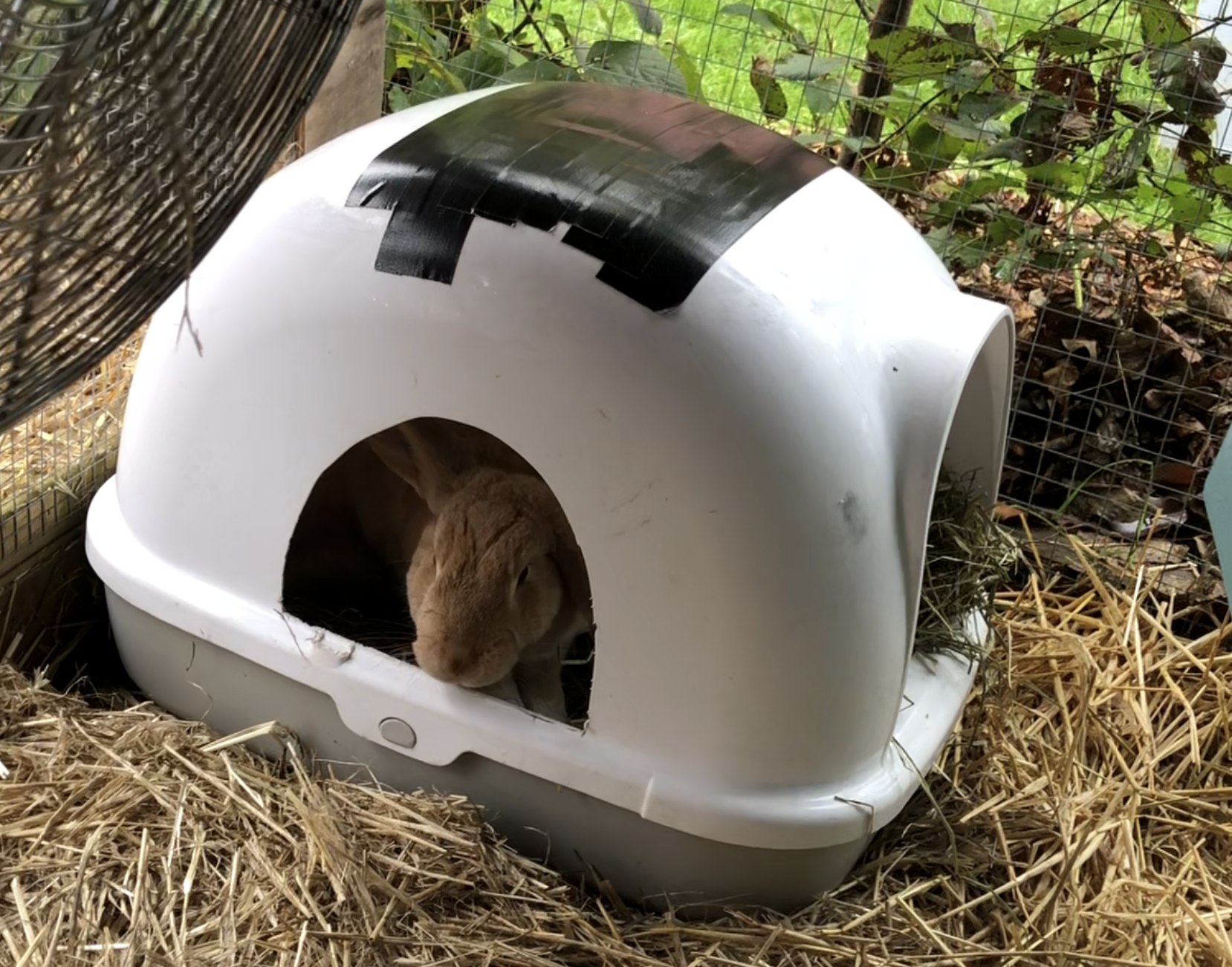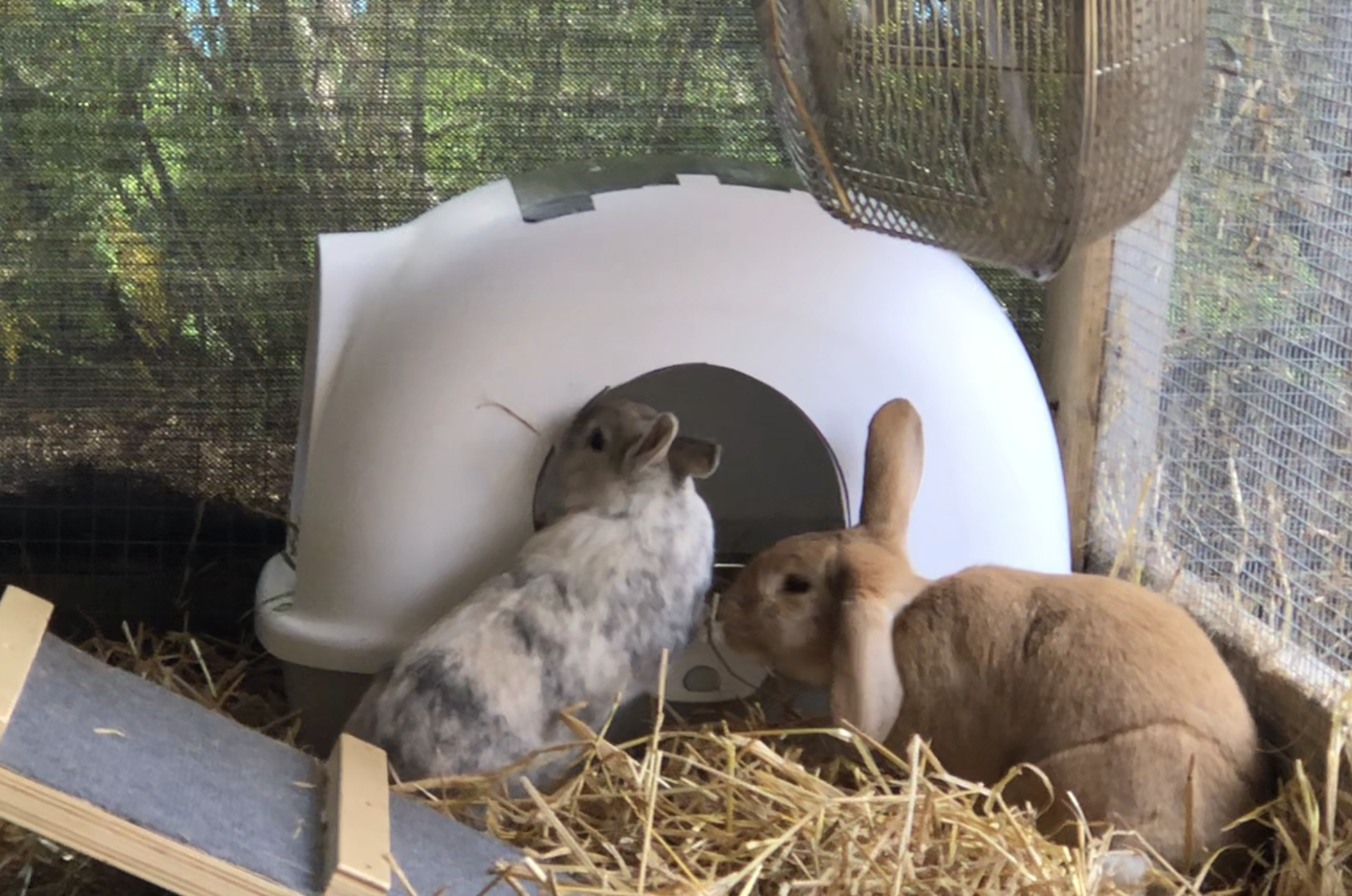Litterbox / Toilet Training
By nature, rabbits choose one or a few places (usually corners) to deposit their urine and most of their poops. Urine-training involves little more than putting a litterbox where the rabbit chooses to go. Poop training requires only that you give them a place they know will not be invaded by others. Here are some suggestions to help you to train your rabbit to use the litterbox.
Does Age Make a Difference?
Older rabbits are easier to train than younger rabbits, especially babies. A rabbit’s attention span and knack for learning increases as they grow up. If you have a baby, stick with it! And if you are deciding whether to adopt an older rabbit, or litter train your older rabbit, go for it!
Does spaying/neutering make a difference?
Yes! This is often the most important factor. When rabbits reach the age of 4-6 months, their hormones become active and they usually begin marking their territory. By spaying or neutering your rabbit, he will be more likely to use his litterbox (as well as be much healthier and happier).
What types of litter should I use?
It depends on what’s available in your area and what your rabbit’s habits are. Keep in mind the following as you choose your litter:
most rabbits spend lots of time in their litter boxes
rabbits will often nibble some of the litter - but covering it with lots of hay helps stop this.
rabbit urine has a very strong odour.
The best litters to use are pine wood fire pellets or recycled paper pellets. Stay away from litters made from shavings or chips, as these products are thought to cause liver damage in rabbits who use them. Never, ever use clay, crystal or clumping cat litters - this includes Tofu litter. Whilst I love this and use it for my own cat, I’d not use it for rabbits because the chances they will eat it are too high. It would definitively cause a blockage if eaten.
Some bun carers prefer to offer a double litter tray with a plastic mesh inner -
Another approach is to simply use the hay itself as litter. It is helpful to put several layers of newspaper under the hay, to absorb the urine so that your rabbit is not standing in it. Most newspapers today use ink which is safe for your rabbit, but check with your local newspaper to make sure first. Obviously, you need to change the hay daily, since your rabbit will be eating it. This method often helps to encourage good litter habits as well as to encourage hay consumption, since rabbits often eat at or near the same time as they use the litter box.
Do not use the following litters
* Clay litter. It is dusty–if your bunny is a digger, the dust can make her vulnerable to pneumonia and can cause intestinal blockages if ingested and the deodorant crystals in some clay litters are toxic.
* Clumping litters - including Tofu Litter. These will clump inside the rabbit’s digestive and respiratory tracts (the latter if they manage to make enough dust to breathe) causing serious problems including blockages and often lead to death.
* Pine and cedar shavings. These emit gases that cause liver damage when breathed by the bunny.
* Litters made from Aspen are safe but shavings do very little to control the odour of urine and often stick to the rabbit’s fur only to be tracked all over the house. They quickly turn into a wet mess and need to be replaced often.
Do use these litters
* Newspaper is absorbent, but doesn’t control odour and needs to be replaced often.
* Litter made from paper pulp or recycled paper products. These litters are very absorbent and cut down on odours. They can be composted.
* Some people have reported success with peat moss which can also be composted. However, it needs to be kept damp to prevent dust inhalation.
* Compressed sawdust pellets is an inexpensive, highly absorbent litter and is what we use here at Westley’s World. They are made from pine sawdust, but they are not toxic because the phenolic compounds are removed during the manufacturing process. Their wood composition helps control bacterial growth and odours.Pine wood fuel pellets are available from Bunnings, Mitre10, some supermarkets and some service stations. All brands of plain pine wood fuel pellets are safe to use. Firetime and Nature’s Flame are the two most common brands. Another option is Equine Natural Animal Bedding pellets which are available from Animal Health Direct.
The pellets break down into urine soaked sawdust which can be composted.
Setting up the litter tray
Whatever you use as litter in your litter tray the one thing that you should always include is LOTS of fresh hay!
Place a layer of litter in the bottom and cover with a good layer of hay. Then stack a big handful of hay at one end for your rabbit to eat and top this up a couple of times a day. Using a hay feeder is not essential. Most rabbits are quite happy to fossick around in their litter trays for the hay they find most appealing. However for many establishing a pooping and peeing ‘end’ and an eating end works well for them. If you do want to use a hay feeder it is important that the hay is readily accessible to the rabbit. If they have to work hard to get their hay, they will reduce the amount they are eating.
Cleaning and disposal
Clean litter boxes often, to encourage your rabbit to use them. Use white vinegar to rinse boxes out – for tough stains, let pans soak. Accidents outside of the cage can be cleaned up with white vinegar or club. If the urine has already dried, you can try products like “Nature’s Miracle” to remove the stain and odour. To dispose of organic litters, they can be used as mulch, be composted or disposed of in your garden refuse bin (double check with your bin service provider first). Rabbit poops can be directly applied to plants and the garden as fertiliser.
What kinds of trays work best?
AVOID Triangle litter trays. These are far too small for rabbits and many will avoid using them.
Do Use - Large, deep cat litter trays work well as do storage tubs and under bed storage crates.
I really like the following two tubs as well as they have high sides and are nice and big. Both of these were purchased from Bunnings.
What if I don’t use a cage?
If you don’t use a cage, you still need to give the bun a particular area to call its own - it’s own ‘bedroom’. Just put a litter box(es) wherever the bunny seems to prefer.
Poops vs. urine
All rabbits will drop poops around their cages to mark it as their own. This is not failure to be litter-trained. It is very important for your rabbit to identify the cage as her property so that when she leaves the cage for the bigger world of your house, she will distinguish the family’s area from her own and avoid marking it. To encourage this, make the rabbit the king of his cage. Try not to force him in or out of it – coax him instead. Do not do things to his cage that he doesn’t like, or things to him that he doesn’t like while he’s in the cage.
The trick to getting the rabbit to keep his poops in their area is to give them ownership of their cage – respect their ownership of the bun zone.
* Don’t reach into the setup to take him out; open the door and let him come out if and when HE wants to come.
* Don’t catch him and put him back in the setup or it will be his prison, not his home. Herd him back gently, and let him choose to go in to get away from you. You can walk behind your buns, clap your hands, and say “bedtime.” Don’t stop harassing them with this until they go into their cage, so they will usually run in except when they feel they haven’t gotten their fair share of time outside the cage.
* If the rabbit has been snuggling with you, it’s okay to carry them to the door of their area and let him go in – just don’t put him in directly, and never chase and trap him and put him in his zone.
* Don’t reach into the bun zone to get food dishes – place them near the door so they can be filled with a minimum of trespassing into the bun zone, or wait until the rabbit is out to fill them.
* Don’t clean the bun zone while the rabbit is in it – wait until he comes out. He’ll come over and supervise you, even help you move things around that you’ve set down outside the cage, but as long as he isn’t in there, he won’t see your cleaning as an invasion of his territory.
The same technique can be used if a rabbit doesn’t live in a specific zone, but in a particular part of a room. Mark the territory with a rug, tape, whatever, and don’t trespass over that.
Can the rabbit have a running space?
Even if your goal is to let your rabbit have full run of the house, you must start small. Start with a cage and a small running space, and when your rabbit is sufficiently well trained in that space, gradually give her more space. But do so gradually! If you overwhelm her with too much freedom before she’s ready, she will forget where her box is and will lose her good habits.
So what’s the actual method?
Start with a box in the rabbit’s ‘bedroom’ space, and one or more boxes in the rabbit’s running space. If bun urinates in a corner of their bedroom not containing a box, move the box to that corner until they get it right. Don’t be concerned if your bun curls up to sleep in his litterbox–this is natural. Once they are using the box in their bedroom, open the door and allow them into their running space. Watch them go in and out on their own. If they head to a corner where there’s no box, or lifts up her tail in readiness to pee either place another box there or gently herd them back to their cage and their litterbox, or into one of the boxes in their room. Be careful, however. You don’t want to make the bedroom or the litterbox seem like punishment. Make sure to have lots of hay in the box. This makes it a really welcoming place. After they first use the box, praise them and give them their favourite treat. Once they use the box in their room a couple of times, you’re well on your way, as their habit for using their box will be becoming established. As they get better trained in their bedroom, you can increase their space. Don’t hurry this process. If the area becomes very big, or includes a second floor, be sure to include more litterboxes, so as not to confuse your rabbit. Remember, as they become more confident and use fewer boxes, you can start to remove some of the early, “training” boxes. Get your rabbit into a daily routine and try not to vary it. Rabbits are very habitual and once a routine is established, they usually prefer to stick with it.
How many litterboxes?
The more, the merrier, especially if your rabbit is a bit of a slow learner, or is especially obstinate about where she wants her box(es) to go. Asyour rabbit’s habits improve, you can decrease the number of litterboxes.
Sometimes you have to work out a compromise...
My two had a literal BANK of Litter trays. Lola; who was inclined to be a bit of a 'freedom pee machine' (especially when I had a lot of other rabbits coming and going) ‘agreed’ to use these two puppy training fake grass pee stations when she felt the need to pee outside of the litter tray instead of marking on the jute mats in their bedroom pen.
Kicking litter out of the box
Some rabbits love to kick their litter out of the box. You can get a covered litterbox (with a hood) to help solve this problem. A high sided box can help as well. If your rabbit has trouble jumping in then you can cut an entry hole in the side or cut one side down to provide easier access. You can also try experimenting with different litters.
Urinating over the edge of the litterbox
A second problem is that rabbits often back up so far in the litterbox - I call it the ‘butt jack,’ that the urine goes over the edge. Again, a covered litterbox can solve this problem. Another solution would be to use a litter tray with higher sides. Still another solution would be to get a “urine guard” to place around the back of the cage, to keep the litter from spraying outside of the cage.
What to do if your rabbit insists on using another spot?
Compromise. If your rabbit continually urinates in a spot where there is no litterbox, put his box where he will use it, even if it means rearranging his zone or moving a table in the living room. It is much easier to oblige him than to try to work against a determined bunny!
What are the most common litter training mistakes?
* Letting the bunny out of their zone and not watching her with undivided attention; You can’t watch TV or read the paper or knit or talk on the phone and expect to keep your mind on what the bunny is doing every second – if she urinates without being “caught” and herded to the litter box, she’ll be that much slower in learning what she’s supposed to do.
* Being in a hurry. Bunnies take time. Perhaps that’s one of their special gifts to us in this hectic world. They require that we take time out to sit and watch and do nothing else. Besides getting a well-trained bunny for your efforts, you also get a short period of time each day to watch one of the most charming little creatures on earth explore, skip for joy, and in general entertain you with her bunny-ness.
What should I do if my rabbit starts dribbling all over her cage instead of using the litter box?
Dribbles usually indicate a bladder infection. Get your bunny to a rabbit-veterinarian who will probably put her on an antibiotic. If the dribbling stops, you know that that was the problem.
If the “dribbles” are more than dribbles, or if the antibiotic doesn’t stop the problem, consider behavioural issues - any factors that may be making your bunny feel insecure (new pet, house guests, change in location of cage, etc.), any of which can cause a bunny to mark her cage more enthusiastically (similar to someone having a dispute with a neighbour about the location of a fence setting up a flag at the property boundary marker). Additional things to keep in mind are other illnesses or conditions that can cause urinary incontinence - EC, renal disease, bladder sludge and/or stones.
Why does my rabbit urinate or leave poops right beside the litterbox?
The three most common things that are related to poor litter habbits (especially if the bun had been using the litterbox in the past) are:
* Urinary Tract infections, sludge in the bladder, bladder stones, kidney disease. This should be investigated, diagnosed and treated by a qualified rabbit savvy vet.
* Behaviour related. Once the possibility of physiological causes is eliminated, the behavioural reasons seem to go something like this:
Miz Bun eliminates next to her litterbox because of some stress, eg, a break in her routine such as less or more running time than usual, visitors at home, kids home from college or summer camp, any intensely emotional event whether good or bad. It could even be a single incident such as being frightened by a sudden noise (car backfiring, etc) while she’s in her box, which she then associates with being in the box. Whatever the reason, she’s feeling insecure and tries to rebuild her confidence by “underlining her signature” (signature being her droppings in the box; underlining, the puddles/piles beside it). Unless it’s an ongoing stress that can be removed, figuring out the cause is not particularly relevant. The important factor is not what happened the first time but the habit that often grows from it. She pees beside the box today because she did it yesterday. Many people do not take action for the first few incidents, especially with a rabbit who’s always been good about using the litterbox. They figure it’s a fluke that will disappear as suddenly as it started. this gives the habit time to take firm root. By day 3, the habit is fairly entrenched, and correction of the perceived cause will not solve the problem.
So what WILL solve it? The usual: confinement, praise, rewards, vigilant observation and supervision during free-run time. But there’s a catch-22 to this method. It generally requires a change in Miz Bun’s routine, which is a common cause for the behaviour in the first place. I know of no easy way around this knot. The hard way is to confine, praise, etc with minimal change to her usual routine. Sometimes I add a box to the rabbit’s area. The novelty makes the box attractive (as do treats placed in it). She hops in to investigate, and voila! she eliminates IN A BOX. This is good behaviour, worthy of lavish rewards. It’s often easier to get her to go in a new box than to go in the one she’s been eliminating next to. It’s important for people to understand that this process can take time. A rabbit who’s been perfectly box-trained for three years and has peed next to the box for three days may need three weeks of intensive training to get back to her old, good behaviour. Why is it that bad habits take longer to undo than to initiate while the reverse is true of good habits?
* Territory related. Winston, a religious litterbox user began urinating on the floor next to the litterbox near the gate…when Buttercup arrived on the opposite side of the gate. After Winston got used to Buttercup, and had “his” territory sufficiently marked, he stopped using the floor and resumed using the litterbox.
Source, with edits:
Litter Training - The House Rabbit Society
What about Outside?
It is possible to toilet train outdoor rabbits as well - especially if they are desexed. The same principle applies - let them chose where they want to go and then provide a suitable toilet in that spot.
I find the a covered K-Mart cat liiter tray really useful for this. I use duct tape over the top to keep water out and position the door away from the prevailing weather. You can also use a combination of this litter tray underneath a K-Mart children's picnic table. I also cut an extra doorway in the side of the Litter tray cover to make it more inviting to the rabbit(s).
Placing a footstool beside the table (I position it so the extra doorway in the side opens to under the footstool) helps less ‘hoppy’ rabbits access the top of the table.
Further info about pee - including cleaning up mistakes can be found in the Pee file.
Further Reading:
Litter Training Your Pet Rabbit - My House Rabbit




